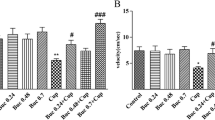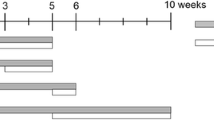Abstract
Multiple sclerosis is a chronic demyelinating disease with a functional disturbance in the immune system and axonal damages. It was shown that Apamin as a blood–brain barrier shuttle acts as a Ca2+ activated K+ channels (SK channels) blocker. In this study, the effects of Apamin on oligodendrocyte differentiation markers were evaluated on an induced model of MS. Briefly, C57BL/6 male mice (22 ± 5 g) except the control group were fed with 0.2% (w/w) cuprizone pellets for 6 weeks. After cuprizone withdrawal, mice were divided randomly into six groups. Apamin (100 µg/kg/BW) was administered intraperitoneally as a co-treatment during phase I (demyelination) or post-treatment phase II (remyelination) twice a week. Mice were anesthetized, perfused with phosphate-buffered saline, then fixed brains were coronally sectioned and the changes in oligodendrocytes markers such as Olig2, PDGFR-α, and BrdU incorporation were assessed by immunohistochemistry assay. Apamin administration increased Olig2+ cells in phase I as compared to the control group (p < 0.0001). Also, a decreasing trend in PDGFRa+ cells observed after cuprizone withdrawal (p < 0.001). 5-Bromo-2′-deoxyuridine (BrdU) incorporation test was confirmed stimulation of oligodendrocyte progenitor cell proliferation in phase I in the Apamin exposed group (p < 0.0001), especially at the subventricular zone. This study highlights the potential therapeutic effects of Apamin as a bee venom–derived peptide on oligodendrocyte precursor proliferation and elevation in myelin content in an oxidative induced multiple sclerosis model due to cuprizone exposure.



Similar content being viewed by others
References
Aliomrani M, Sahraeian MA, Khoshayand MR, Danesh Seta T, Sharifzadeh M, Ghahremani MH (2019) The prevalence of the genetic polymorphism of GSTM1, GSTT1 AND GSTP1 and its relationship with clinical criteria of multiple sclerosis (Ms) patients in Tehran. Journal of Babol University of Medical Sciences 21(1)
Aliomrani M, Mesripour A, Sayahpour Z (2021) AChR is partly responsible in mice depressive-like behavior after phosalone exposure. Neurotoxicol Teratol 84:106957
Aliomrani M, Sahraian MA, Shirkhanloo H, Sharifzadeh M, Khoshayand MR, Ghahremani MH (2017) Correlation between heavy metal exposure and GSTM1 polymorphism in Iranian multiple sclerosis patients. Neurol Sci 38(7):1271–1278
Aliomrani M, Sahraian MA, Shirkhanloo H, Sharifzadeh M, Khoshayand MR, Ghahremani MH (2016) Blood concentrations of cadmium and lead in multiple sclerosis patients from Iran. Iranian Journal of Pharmaceutical Research: IJPR 15(4):825
Carpena M, Nuñez-Estevez B, Soria-Lopez A, Simal-Gandara J (2020) Bee venom: an updating review of its bioactive molecules and its health applications. Nutrients 12(11):3360
Crawford AH, Chambers C, Franklin RJM (2013) Remyelination: the true regeneration of the central nervous system. J Comp Pathol 149(2–3):242–254
Đặng TC, Ishii Y, De Nguyen V, Yamamoto S, Hamashima T, Okuno N, Nguyen QL, Sang Y, Ohkawa N, Saitoh Y (2019) Powerful homeostatic control of oligodendroglial lineage by PDGFRα in adult brain. Cell Rep 27(4):1073–1089
Davidson A, Diamond B (2001) Autoimmune diseases. N Engl J Med 345(5):340–350
Dawson MRL, Levine JM, Reynolds R (2000) NG2-expressing cells in the central nervous system: are they oligodendroglial progenitors? J Neurosci Res 61(5):471–479
Eze OB, Nwodo OF, Ogugua VN (2016) Therapeutic effect of honey bee venom. Proteins (Enzymes) 1(2)
Gholami S, Mirian M, Eftekhari SM, Aliomrani M (2020) Apamin administration impact on MiR-219 and MiR-155-3p expression in cuprizone induced multiple sclerosis model. Mol Biol Rep 47(11):9013–9019
Gold R, Wolinsky JS (2011) Pathophysiology of multiple sclerosis and the place of teriflunomide. Acta Neurol Scand 124(2):75–84
Golmohammadi J, Jahanian-Najafabadi A, Aliomrani M (2019) Chronic oral arsenic exposure and its correlation with serum S100B concentration. Biological Trace Element Research 189(1). https://doi.org/10.1007/s12011-018-1463-2
Greenstein JI (2007) Current concepts of the cellular and molecular pathophysiology of multiple sclerosis. Dev Neurobiol 67(9):1248–1265
Gudi V, Gingele S, Skripuletz T, Stangel M (2014) Glial response during cuprizone-induced de-and remyelination in the CNS: lessons learned. Front Cell Neurosci 8:73
Hauser RA, Daguio M, Wester D, Hauser M, Kirchman A, Skinkis C (2001) Bee-venom therapy for treating multiple sclerosis: a clinical trial . Alternative & Complementary Therapies 7(1):37–45
Hemmer B, Archelos JJ, Hartung H-P (2002) New concepts in the immunopathogenesis of multiple sclerosis. Nat Rev Neurosci 3(4):291–301
Jung HS, Seo MS, An JR, Kang M, Heo R, Li H, Jung W-K, Choi I-W, Cho E-H, Park H (2020) The vasodilatory effect of gemigliptin via activation of voltage-dependent K+ channels and SERCA pumps in aortic smooth muscle. Eur J Pharmacol 882:173243
Lassmann H, Brück W, Lucchinetti CF (2007) The immunopathology of multiple sclerosis: an overview. Brain Pathol 17(2):210–218
Leray E, Moreau T, Fromont A, Edan G (2016) Epidemiology of multiple sclerosis. Revue Neurologique 172(1):3–13
Marques AA, Macedo CH, da Silva F, de Souza P, de Almeida CLB, Cechinel-Filho V, Lourenço ELB, Junior AG (2020) Nitric oxide and Ca2+-activated high-conductance K+ channels mediate nothofagin-induced endothelium-dependent vasodilation in the perfused rat kidney. Chem Biol Interact 327:109182
Mazloumfard F, Mina M, Seyed-Mehdi E, Mehdi A (2020) Hydroxychloroquine effects on MiR-155–3p and MiR-219 expression changes in animal model of multiple sclerosis. Metabolic Brain Disease, 1–9
Mohammadi-Rad M, Ghasemi N, Aliomrani M (2019) Evaluation of apamin effects on myelination process in C57BL/6 mice model of multiple sclerosis. Research in Pharmaceutical Sciences 14(5):424
Olsson T, Barcellos LF, Alfredsson L (2017) Interactions between genetic, lifestyle and environmental risk factors for multiple sclerosis. Nat Rev Neurol 13(1):25
Paknejad B, Shirkhanloo H, Aliomrani M (2019) Is There any relevance between serum heavy metal concentration and BBB leakage in multiple sclerosis patients? Biol Trace Elem Res 190(2):289–294
Pakzad D, Vajihe A, Mohammad RS, Mehdi A (2021) Risk of neurodegenerative disease due to tau phosphorylation changes and arsenic exposure via drinking water. Toxicology Research
Park J, Jang KM, Park K-K (2020) Apamin suppresses LPS-induced neuroinflammatory responses by regulating SK channels and TLR4-mediated signaling pathways. Int J Mol Sci 21(12):4319
Reynolds R, Cenci I, di Bello M, Dawson, and Joel Levine. (2001) The response of adult oligodendrocyte progenitors to demyelination in EAE. Prog Brain Res 132:165–174
SEYED KNA, Sina A, Kamyar G, KHOUEI NAS, OMIDI YA (2009) Melittin and hyaluronidase compound derived from bee venom for the treatment of multiple sclerosis
Sharifan A, Etebari M, Zolfaghari B, Aliomrani M (2021) Investigating the effects of bark extract and volatile oil of pinus eldarica against cisplatin-induced genotoxicity on HUVECs cell line. Toxicology Research
Shimpi R, Chaudhari P, Deshmukh R, Devare S, Bagad Y, Bhurat M (2016) A review: pharmacotherapeutics of bee venom. Word J Pharm Pharm Sci 5(7):567–656
Sugiarto S, Persson AI, Munoz EG, Waldhuber M, Lamagna C, Andor N, Hanecker P, Ayers-Ringler J, Phillips J, Siu J (2011) Asymmetry-defective oligodendrocyte progenitors are glioma precursors. Cancer Cell 20(3):328–340
Tiane A, Schepers M, Rombaut B, Hupperts R, Prickaerts J, Hellings N, van den Hove D, Vanmierlo T (2019) From OPC to oligodendrocyte: an epigenetic journey. Cells 8(10):1236
VENOM, BIOLOGICAL ACTION OF BEE (n.d.) Biological and therapeutic properties of bee venom
Voos P, Yazar M, Lautenschläger R, Rauh O, Moroni A, Thiel G (2017) The small neurotoxin apamin blocks not only small conductance Ca 2+ activated K+ channels (SK type) but also the voltage dependent Kv1. 3 channel. Eur Biophys J 46(6):517–523
Funding
This work was supported by the Iran National Science Foundation (INSF).
Author information
Authors and Affiliations
Corresponding author
Ethics declarations
Conflict of Interest
The authors declare no competing interests.
Additional information
Publisher's Note
Springer Nature remains neutral with regard to jurisdictional claims in published maps and institutional affiliations.
Rights and permissions
About this article
Cite this article
Danesh-Seta, T., Emami, F., Nasr-Esfahani, M.H. et al. Bee Venom–Derived BBB Shuttle and its Correlation with Oligodendrocyte Proliferation Markers in Mice Model of Multiple Sclerosis. Neurotox Res 39, 1181–1188 (2021). https://doi.org/10.1007/s12640-021-00361-x
Received:
Revised:
Accepted:
Published:
Issue Date:
DOI: https://doi.org/10.1007/s12640-021-00361-x




